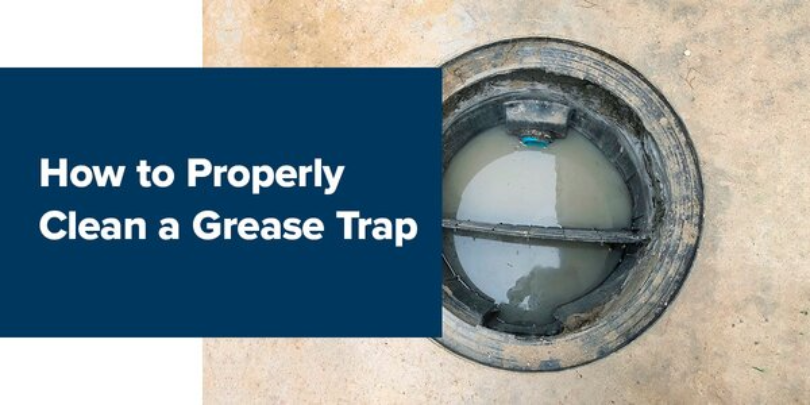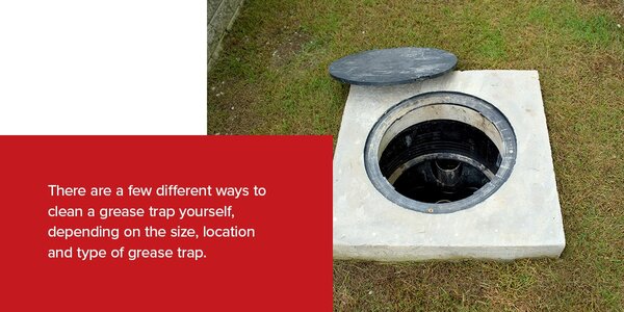
Grease traps are amazing tools that help keep your establishment smelling great, so your customers keep coming back. They’re also often the biggest annoyance that restaurants face, especially if you forget to clean them on a regular basis.
Proper grease trap maintenance can keep your restaurant running smoothly, and a commercial plumbing service can ensure you don’t get any of the smelly, expensive backups that occur when you don’t catch the fats, oils and grease before they entire your sewer line.
Where Are Grease Traps Located?
Commercial grease traps are typically located outside of your main building. Look in the ground near the walls by your kitchen’s dishwashing station — they look similar to a manhole or a septic tank cover. If your commercial kitchen has a basement, you may also find your above-ground grease trap down there so it stays away from the frost.

How to Properly Clean a Grease Trap
First, you’ll want to wait until your restaurant is closed for the day and all items have been cleaned. You can also consider cleaning your grease trap early in the morning before you start your opening procedures.
There are a few different ways to clean a grease trap yourself, depending on the size, location and type of grease trap. You will need some items to clean your grease trap thoroughly, including:
- A crowbar or wrench
- Rubber gloves
- A nose plug or gas mask
- Scrapers
- A shop vacuum
- A ruler
- Buckets
- Garbage bags
If you have a small grease trap that is easy to access, out on your gloves and follow these steps to keep it clean.
Remove the Lid
Detach the grease trap's lid slowly and gently to protect the gaskets on the lid.
Note Part Locations
Inspect the grease trap's parts and either take a picture or draw a diagram of where everything belongs. This documentation will help you remember where to replace parts after you clean them.
Measure Waste
Place a ruler in the grease trap to note how much waste there is. Write this information down in a Fatty Oils and Grease (FOG) report provided by the Environmental Protection Agency (EPA).
Empty Water Out
You can use a bucket or a small pump to remove water and set it aside, if you wish to pour it back into the drain after collecting the waste.
Scoop Out Waste
Use another bucket or heavy-duty scooper to scoop waste out of the trap. Place the waste in a water-tight garbage bag so you can easily dispose of it later.
Wash Surfaces
Scrape the interior to remove any excess grease. You can also use a shop vacuum to suck out smaller bits of waste or bits stuck in hard-to-reach places.
Scrub your grease trap with a steel pot scrubber and some soap and water. Flush the screens and parts out with water to remove the soap and leftover waste.
Test, Reinstall and Clean Up
Ensure your grease trap is clean and blockage-free by draining a gallon of clean water from the sink. The trap should allow the water to flow through. If there is any blockage, contact a licensed plumber to help you fix the situation.
Once you have confirmed your grease trap is clean and ready to go, you can pour the water back into your grease trap and reinstall the parts by following the picture you took or the diagram you drew. Replace the lid once the various components are secured and working.
Properly dispose of the waste you have collected in a double-lined garbage bag.
Keep Up Maintenance
Maintain regular grease trap cleaning to ensure your establishment runs safely, smoothly and efficiently.
Be sure to copy your FOG report for your records and send the original to the address listed on the report.
Grease Trap Maintenance — Is It Time for a Replacement?
One of the best ways to know it’s time to replace your grease trap is when your local municipality requests an inspection because of grease leaking into the local water system — if possible, you should maintain your grease trap before it gets this bad. You should also consider replacing the system if it constantly backs up, stops filtering grease out of your water, becomes too hard to clean or causes smells in your kitchen.
Whether you need a cleaning, service, disposal of grease at licensed facilities or a full replacement of your grease trap system, Mr. Rooter of Oneida offers reliable commercial plumbing services. Contact us today!

